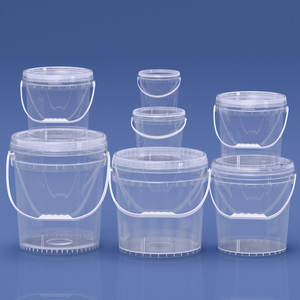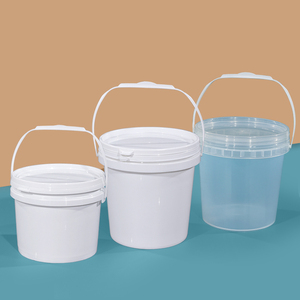
All categories
Featured selections
Trade Assurance
Buyer Central
Help Center
Get the app
Become a supplier

(1061 products available)




































A 100-gallon plastic drum comes in a variety of types suited for different functions.
Open-head plastic drums are suitable for storing and transporting materials that require frequent access, such as chemicals, paints, and food products. They come with removable lids secured by rings and are ideal for materials that need to be scooped out or poured.
Closed-head drums have non-removable tops with small bungholes that are used for sealing liquids that don’t require access once filled. This type of drum is widely used in industries for transporting liquid chemicals, oils, and other sensitive liquids that require a tight seal.
The bell-head design is similar to open-head drums, except the heads are slightly raised. It allows for pouring out the contents easily, which is especially useful for thick or viscous materials. This makes it well-suited for materials such as paints or industrial additives.
These drums have a conical shape on the top, which allows the contents to settle toward the center and thus makes it easier to drain the contents completely when needed. This design is crucial for storing chemicals that may settle or need mixing.
These drums are made through an extrusion process to ensure a continuous uniform wall thickness. They are particularly resistant to impacts and UV rays, making them suitable for outdoor storage.
Durability and Strength
100-gallon plastic drums are made from tough HDPE, ensuring they withstand impacts, UV rays, and harsh chemicals. Light weight makes them portable for easy handling. This durability makes them suitable for both indoor and outdoor storage, especially in industries dealing with corrosive substances.
Capacity and Size
The 100-gallon capacity provides ample space for storing liquids, chemicals, or solids. Standard sizes fit storage requirements and regulations, making them practical for bulk storage needs. The cylindrical shape ensures efficient use of space.
Closure Types and Seals
Available with tight seals or vented options, these drums ensure liquids remain contained. A good seal prevents leaks and contamination while a vented type allows gases to escape safely. Proper closure types are essential to comply with safety regulations.
Resistance to Chemicals
HDPE construction provides resistance against acids, alkalis, and solvents, making it a choice for industries like agriculture and manufacturing. This resistance protects the contents, keeps them in good condition, and ensures the safety of the storage area.
Reusability and Recycling
100-gallon plastic drums are designed for multiple uses, making them eco-friendly by reducing waste. After the first use, they can be cleaned and repurposed for various storage needs. They can also be recycled when worn out, contributing towards sustainable practices in industries.
A plastic 100-gallon barrel can be put to multiple uses.
Often, 100-gallon plastic drums are seen in industries used to store liquids and chemicals. Their size allows for the storage of large quantities of materials, saving on refill time. The durable plastic keeps the contents safe from contamination and degradation, making it ideal for storing hazardous or valuable substances in factories.
In agriculture, these drums store water, fertilizers, or pesticides. They help in irrigation systems by transporting and distributing water. Because of their resistance to chemicals, they are ideal for farmers to keep fertilizers and pesticides safe without spoilage.
Plastic barrels provide a reliable way to store emergency water supplies. They are resistant to contaminants, making stored water clean and safe for use in emergency situations. In rural areas, they are used to store rainwater for daily consumption. Properly treated and sealed, the water remains fresh for extended periods.
These drums play a role in collecting and separating waste in industries. Their large capacity allows workers to fill them before moving to the next disposal point, improving efficiency. Certain colored drums mark the type of waste they should be collected, making sorting hazardous waste easier.
Transportation is yet another task performed by these 100-gallon plastic drums. Their sturdy build ensures that goods, especially liquids, arrive safely without spillage. Many international shipping companies accept them for transporting chemicals, oils, or liquid foods while complying with safety regulations.
In areas with scarce water supply, these drums are used in systems of rainwater harvesting. They collect rainwater off rooftops, providing a sustainable source of water for irrigation and garden use. With basic maintenance, the collected rainwater helps reduce the reliance on municipal water supply.
Some other common uses of these 100-gallon plastic drums are artistic creations, such as a stormwind art piece, as well as furniture, like a garden table, etc.
Several factors should be considered when selecting a plastic 100-gallon water tank and suitable accessories for it.
Vented 100-gallon plastic drums allow gases to escape and are ideal for storing or transporting volatile substances. Such materials can generate gases and pressure build-up, so it’s better to have a vented drum. On the contrary, non-vented drums provide a tighter seal, making them suitable for transporting or storing liquids that need slow absorption, like oils.
Size is among the most important considerations when choosing a 100-gallon plastic drum. A 100-gallon drum is ideal for large-volume storage needs, so this would suit users having bulk requirements. However, since it is large in size, it would require more space for storage. As such, it is critical to ensure that sufficient space is available prior to purchase so the drum fits properly.
The color of the drum is also vital when making a choice. Generally, blue plastic drums are used for water storage, yellow for hazardous waste, and gray for general storage. The color of the drum may have an effect on the temperature for which it is intended. For example, the black variety is ideal for places with too much sun because it absorbs more heat.
Selecting the right closure type is important based on the contents to be stored. Open-top drums allow easy access, which is useful for materials frequently removed, while closed-top provides a secure, tamper-proof seal suitable for storing liquids that should remain undisturbed. Consider whether a plain seal or a screw-on cap is needed, depending on the storage requirements.
Some 100-gallon plastic drums may have UV protection or antistat additives. These additives improve the durability of the product against environmental effects. For instance, UV protection is great for outdoor storage since it shields the drum from harmful rays of the sun. On the other hand, antistat works well in keeping the drum from becoming brittle, thus ensuring it lasts longer.
A1: Yes, but the food-grade type should be used for food storage. This kind of drum has not been through chemical treatments that might harm health. Still, the drum should be cleaned and sterilized properly before storage.
A2: Maintenance is minimal. However, it is necessary to inspect the drum regularly for any signs of wear, such as cracks or fading. If it’s a non-vented type, the seal should also be checked for leakage now and then. In addition, keep the drum clean to ensure the contents remain safe.
A3: Yes, HDPE plastic drums are recyclable. However, the recycling center must be informed of the type of material it carried so as to give appropriate treatment to the plastic. In other instances, the drum may also be reused for other purposes at home.
A4: Extreme temperatures either way can cause the contents inside the drum to expand and contract. This could lead to a buildup of pressure in the case of closed drums, making them burst. To avoid this, it is recommended that the drum be stored in a place with moderate temperatures and away from direct sunlight.
A5: Begin by rinsing the drum with soap and water. Use a brush to scrub the inside, focusing on corners and areas with residue. For stubborn deposits, a vinegar and baking soda mixture or commercial cleaner can be applied. Thoroughly rinse with clean water to remove all soap or chemical traces before allowing it to air dry completely.